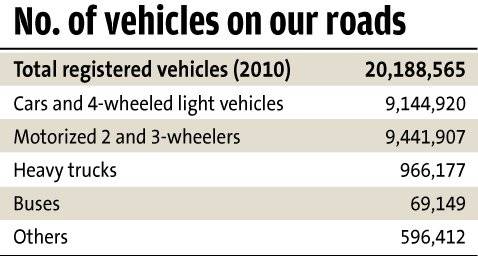Are Malaysian roads becoming safer or more dangerous?

Last Thursday alone, in the span of less than three hours from around 3.30 AM to 6 AM, 14 people were reported killed in horrific accidents on Malaysian roads.
In one accident, a family of four were killed on the spot when the driver of the car lost control over his vehicle and collided with another car coming from the opposite direction, near Ladang Geddes, Pahang.
 A file picture of a twisted car resultant in killing all the four members of a family
A file picture of a twisted car resultant in killing all the four members of a family
In Kampar, a driver attempted to overtake another vehicle along the Ipoh-Kuala Lumpur trunk road but rammed a lorry. The accident claimed four lives, all college students.
Two other accidents took six other lives. This is not the end of the story. There are many more fatal incidents like this that has taken innocent lives in fraction of seconds. The main reason behind this can be measured because of greater economic development and social wealth, leading to increasing urbanization and ownership of vehicles.
Malaysia’s road safety level, as expressed by the number of road deaths per billion vehicle-kilometer, shows a declining trend from 33.6 in 1997, 26.3 in 2000, and 13.4 in 2012. However, Malaysia’s road deaths still remain high in comparison to other countries.
But this increase is partly due to the country’s rise in population and the number of vehicles on our roads. Since 2000, Malaysia’s population increases by an average of 2% per year to 29.3 million people and the number of vehicles by 6.6% per year to 22.7 million registered vehicles. Rapid motorization in this country meant that in 2012, there were 1.3 persons to a vehicle, compared to 2.2 in 2000, 3.9 in 1990, 5.7 in 1980, and 10.8 in 1974.
Read Also: Upcoming Smart Technological ways that assures you a comfortable Ride!
There are many factors to road safety, but they can be grouped into three dimensions: exposure, risk, and consequences. Simply put, a country’s road safety level is related to how exposed people are to accidents during their travels on the roads and how likely of them surviving these accidents should they occur.
Unfortunately, many countries do not collect such data. However, those that do include Malaysia and 22 other countries (such as US, UK, Denmark, Australia, and Germany).
If Malaysia is to achieve this target of 10 or lower deaths per 100,000 vehicles, we Malaysians have to be ready to make some personal sacrifices. So, it isn’t just what the government should do but also what we should do if we want to see our roads safer.
Read Also: ASEAN NCAP: single unified safety rating for every 2017 car model!
 Malaysia’s population, number of registered vehicles, and motorization.
Malaysia’s population, number of registered vehicles, and motorization.
One way to reduce the number of vehicles on the roads is to expand the public transport coverage in the country and encourage more use of public transport in the people’s daily commute. But are Malaysians willing to give up their cars and motorbikes – or at least, greatly reduce their use? This is easier said than done.
These solutions may be unpopular, but they are necessary if we wish to see safer roads. Malaysians cannot simply expect cheaper cars, lower fuel prices, no road tolls, no more new highways to be built, and no AES (Automated Enforcement System), but yet still expect our roads to be safer than before.
Safer roads in Malaysia? Of course we want them. But are we willing to pay the price?
Read Also: Euro NCAP releases new ratings ahead of 2015 Frankfurt Motor Show
Malaysia Autoshow
Trending & Fresh Updates
- Latest
- Popular
You might also be interested in
- News
- Featured Stories
Featured Cars
- Latest
- Upcoming
- Popular
Latest Car Videos on Zigwheels




























































